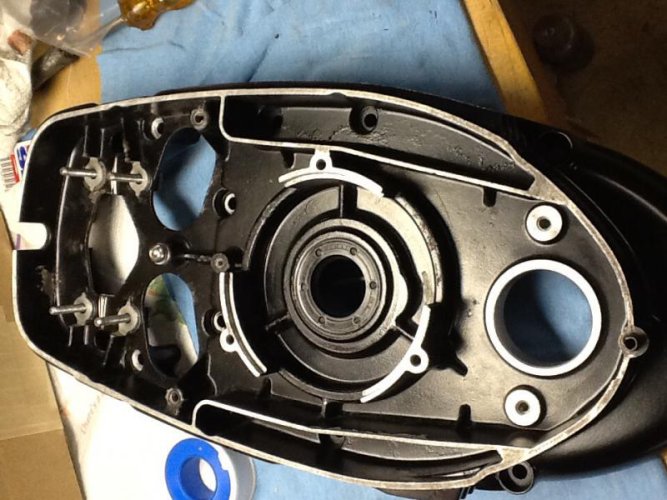ezwicky
Member
Hi all,
After changing out my timing chain, I need to renew the cam and crank seals before I put the cover back on. Looking at Snowbum's and Brook Reams' sites, and various other web searches, as well as advice from Tom Cutter (who I bought all the parts from), there seems to be a variety of opinions on the methodology involved.
Tom told me to heat the cover and push the seals in from the rear of the cover with my fingers and use a drift if I needed to, and set them flush with the rear of the cover. I tried this with a heated cover and lightly-greased seals, and they not only would not push in with my fingers, they would not go all the way in even with a drift (socket). They never went in all the way and I was really forcing things. There were rubber shavings in evidence.
So I popped them back out and for practice, I tried to install them from the front and they went in just fine. When the crank seal is flush with the front, it's also flush with the rear surface. But the cam seal when flush with the front, is not quite all the way to the rear surface.
Looking at other threads, I see where folks change the seals without removing the timing cover. This would suggest that "flush with the front surface" is fine.... otherwise how would you know with the cover *on*, that the seals are flush with the rear surface?
Clymer's says to install the crank seal from the front, with the timing over off, then to install and center the cover, *then* install the cam seal.
I have luckily an extra set of seals, and also a new used timing cover on the way from Hucky's because I have some scratches on the gasket surface and the cam-seal bore on the current one. So when that arrives, I want to do this the right way. Since I had such difficulty installing the other ones from the rear, and they seemed to go in just fine from the front, I guess I am really looking for validation / confirmation that "from the front" is OK, and that "flush with front surface" is also OK.
Thanks in advance, and Happy Holidays,
Eric Z
Media PA
After changing out my timing chain, I need to renew the cam and crank seals before I put the cover back on. Looking at Snowbum's and Brook Reams' sites, and various other web searches, as well as advice from Tom Cutter (who I bought all the parts from), there seems to be a variety of opinions on the methodology involved.
Tom told me to heat the cover and push the seals in from the rear of the cover with my fingers and use a drift if I needed to, and set them flush with the rear of the cover. I tried this with a heated cover and lightly-greased seals, and they not only would not push in with my fingers, they would not go all the way in even with a drift (socket). They never went in all the way and I was really forcing things. There were rubber shavings in evidence.
So I popped them back out and for practice, I tried to install them from the front and they went in just fine. When the crank seal is flush with the front, it's also flush with the rear surface. But the cam seal when flush with the front, is not quite all the way to the rear surface.
Looking at other threads, I see where folks change the seals without removing the timing cover. This would suggest that "flush with the front surface" is fine.... otherwise how would you know with the cover *on*, that the seals are flush with the rear surface?
Clymer's says to install the crank seal from the front, with the timing over off, then to install and center the cover, *then* install the cam seal.
I have luckily an extra set of seals, and also a new used timing cover on the way from Hucky's because I have some scratches on the gasket surface and the cam-seal bore on the current one. So when that arrives, I want to do this the right way. Since I had such difficulty installing the other ones from the rear, and they seemed to go in just fine from the front, I guess I am really looking for validation / confirmation that "from the front" is OK, and that "flush with front surface" is also OK.
Thanks in advance, and Happy Holidays,
Eric Z
Media PA

